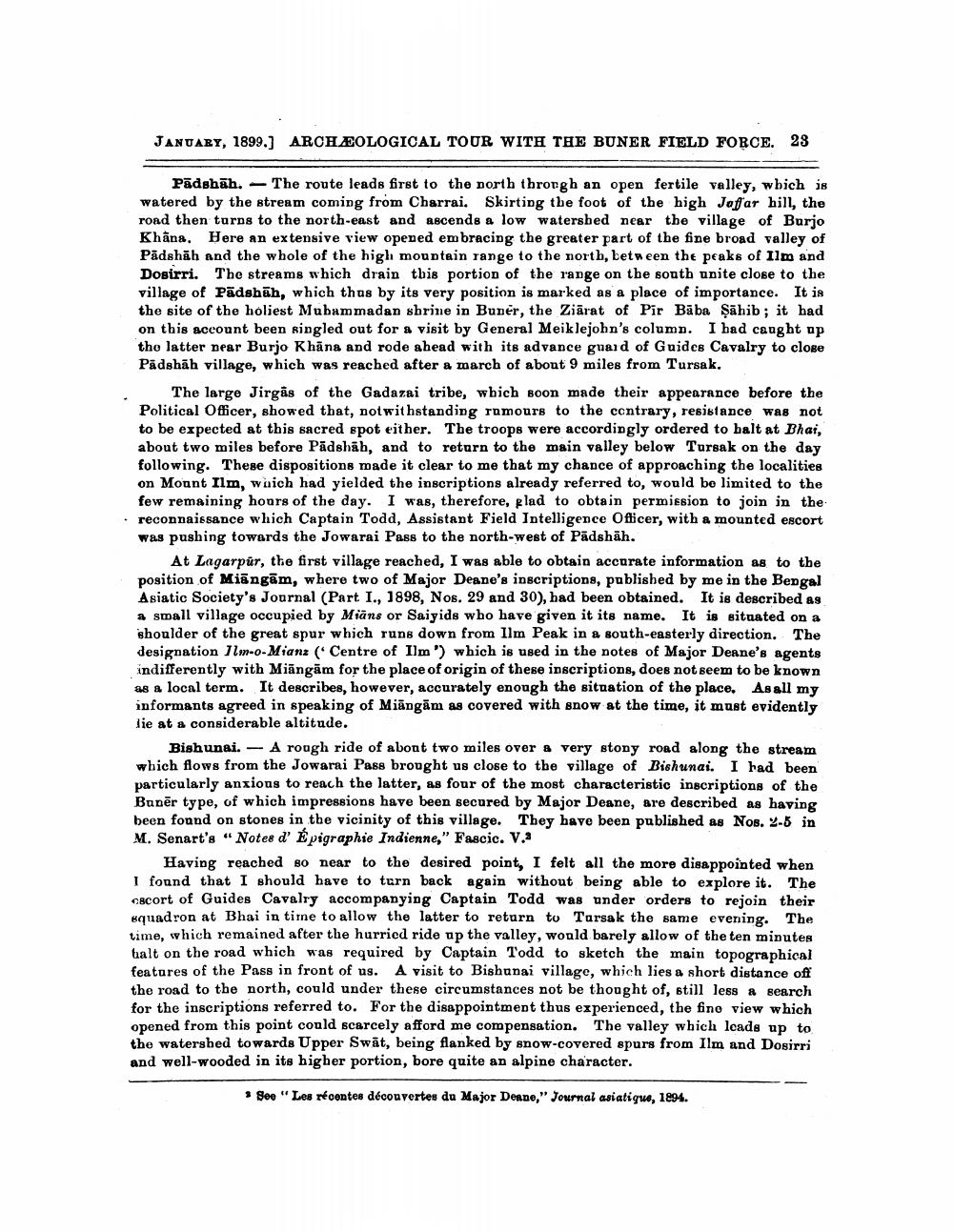________________
JANUARY, 1899.) ARCHAEOLOGICAL TOUR WITH THE BUNER FIELD FORCE. 23
Pādshāh. - The route leads first to the north through an open fertile valley, which is watered by the stream coming from Charrai. Skirting the foot of the high Jaffar hill, the road then turns to the north-east and ascends a low watershed near the village of Burjo Khāna. Bere an extensive view opened embracing the greater part of the fine broad valley of Pādshāh and the whole of the high mountain range to the north, between the peaks of Ilm and Dosirri. The streams which drain this portion of the range on the south unite close to the village of Pādshāh, which thus by its very position is marked as a place of importance. It is the site of the holiest Mubammadan shrine in Buner, the Ziarat of Pir Bāba Şahib; it had on this account been singled out for a visit by General Meiklejohn's column. I had caught op the latter near Burjo Khāna and rode ahead with its advance guard of Guides Cavalry to close Pādshāh village, which was reached after a march of about 9 miles from Tursak.
The large Jirgās of the Gadazai tribe, which boon made their appearance before the Political Officer, showed that, notwithstanding rumours to the contrary, resistance was not to be expected at this sacred spot either. The troops were accordingly ordered to halt at Bhai, about two miles before Pādshāh, and to return to the main valley below Tursak on the day following. These dispositions made it clear to me that my chance of approaching the localities on Mount Ilm, waich had yielded the inscriptions already referred to, would be limited to the
few remaining hours of the day. I was, therefore, glad to obtain permission to join in the • reconnaissance which Captain Todd, Assistant Field Intelligence Officer, with a mounted escort was pushing towards the Jowarai Pass to the north-west of Pādshāh.
At Lagarpur, the first village reached, I was able to obtain accurate information as to the position of Miāngām, where two of Major Deane's inscriptions, published by me in the Bengal Asiatic Society's Journal (Part I., 1898, Nos. 29 and 30), had been obtained. It is described as a small village occupied by Mians or Saiyids who have given it its name. It is situated on a shoulder of the great spur which runs down from Ilm Peak in a south-easterly direction. The designation Ilm-o-Mianz (Centre of Ilm') which is used in the notes of Major Deane's agents indifferently with Miāngām for the place of origin of these inscriptions, does not seem to be known as a local term. It describes, however, accurately enough the situation of the place. As all my informants agreed in speaking of Miāngām as covered with snow at the time, it must evidently lie at a considerable altitude.
Bishunai. - A rough ride of about two miles over a very stony road along the stream which flows from the Jowarai Pass brought us close to the village of Bishunai. I had been particularly anxious to reach the latter, as four of the most characteristic inscriptions of the Banēr type, of which impressions have been secured by Major Deane, are described as having been found on stones in the vicinity of this village. They have been published as Nos. 2-5 in M. Senart's "Notes d' Epigraphie Indienne," Fascic. V.
Having reached so near to the desired point, I felt all the more disappointed when I found that I should have to turn back again without being able to explore it. The cocort of Guides Cavalry accompanying Captain Todd was under orders to rejoin their squadron at Bhai in time to allow the latter to return to Tarsak the same evening. The time, which remained after the hurricd ride up the valley, would barely allow of the ten minutes talt on the road which was required by Captain Todd to sketch the main topographical features of the Pass in front of us. A visit to Bishanai village, which lies a short distance off the road to the north, could under these circumstances not be thought of, still less a search for the inscriptions referred to. For the disappointment thus experienced, the fine view which opened from this point could scarcely afford me compensation. The valley which leads up to the watershed towards Upper Swāt, being flanked by snow-covered spurs from Ilm and Dosirri and well-wooded in its higher portion, bore quite an alpine character.
-
Son "Les récentes découvertes du Major Denne," Journal asiatique, 1894.




